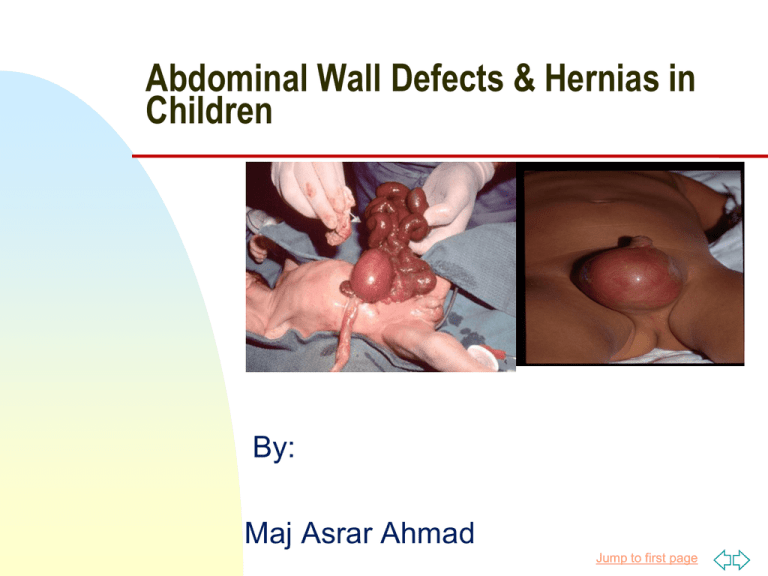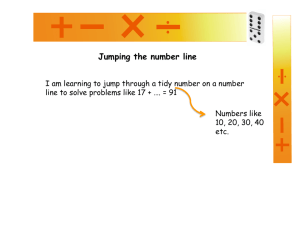Anterior-abdominal-wall-defects
advertisement

Abdominal Wall Defects & Hernias in Children • MM By: Maj Asrar Ahmad Jump to first page Anatomy Jump to first page Embryology Jump to first page Types Omphalocele Gastroschisis Copyright, 1996 © Dale Carnegie & Associates, Inc. Jump to first page Jump to first page Omphalocele Covered by membrane Umbilical cord inserts into the sac Typically contain bowel and/or liver, stomach and spleen Jump to first page Types of Omphalocele Central - failure of fusion of lateral folds Epigastric - failure of fusion of lateral and cephalic folds Hypogastric - failure of fusion of caudal and cephalic folds Jump to first page Omphalocele Jump to first page Comparison GASTROSCHISIS OMPHALOCELE 1:4,000 to 10,000 Covering sac present Cord onto sac Herniated bowel normal Anomalies 45 to 55 % Survival 20%-70% 1:20,000 to 30,000 Covering sac absent Cord onto abdominal wall Bowel edematous, matted Anomalies 10 to 15% Survival 70-90% Jump to first page Omphalocele Jump to first page Associated GI Anomalies Midgut volvulus Meckel’s diverticulum Intestinal atresia Intestinal duplication Malrotation Jump to first page 6 month old infant Jump to first page Beckwith-Wiedemann Syndrome Hepatomegaly, hemihypertrophy Adrenal carcinoma, Wilm’s tumor Gonadoblastoma, hepatoblastoma, large ovaries, hyperplastic uterus and bladder, bicornuate uterus, hypospadias Immunodeficiency Cardiac hamartoma, focal cardiomyopathy Jump to first page Gastroschisis Small abdominal wall defect, lateral to the umbilicus Umbilical cord attached to abdominal wall to the left of defect No limiting sac, viscera often limited to small intestine and ascending colon Jump to first page Gastroschisis Ischemic compromise due to compression of mesenteric blood vessels when defect is small Serositis and serosal peel result from amniotic fluid exposure Ischemic changes and atresia are late events related to mesenteric constriction Jump to first page Hernia of the Umbilical Cord Jump to first page Umbilical Hernia Defect in linea alba, subcutaneous tissue and skin covering the protruding bowel Frequent in premature infants Jump to first page Management ABC (5-Hs) Heat Management Sterile wrap or sterile bowel bag Radiant warmer Fluid Management IV bolus 20 ml/kg LR/NS D10¼NS 2-3 maintenance rate Jump to first page Management Nutrition Gastric Distention OG/NG tube Infection Control NPO and TPN Ampicillin and Gentamicin Associated Defects Jump to first page Management Conservative treatment Reduction by squeezing the sac Painting sac with escharotic agent 0.25% Silver nitrate 0.25% Mercurochrome lotion Jump to first page Management Surgical Management Skin Flaps Primary Closure Staged Closure Staged repair using silo pouch Jump to first page Surgery Jump to first page Skin Flaps Jump to first page Jump to first page Jump to first page Hernias In Children Definition Anatomy Common Types Management Jump to first page Anatomy Jump to first page Jump to first page Jump to first page Types Inguinal Femoral Umbilical Jump to first page Inguinal Hernia Jump to first page Hydrocele Inguinal Femoral Umbilical Jump to first page Types Inguinal Femoral Umbilical Jump to first page Obstructed Hernia Jump to first page Strangulated Hernia Jump to first page Management Jump to first page Management Jump to first page Umbilical Hernia Jump to first page Umbilical Hernia Jump to first page Jump to first page







